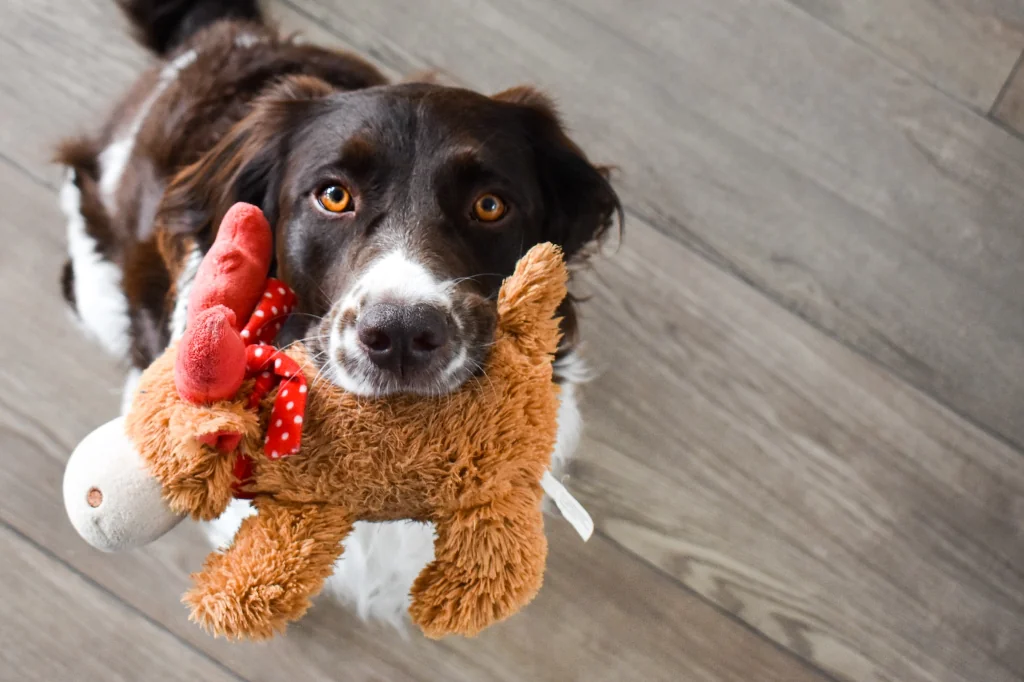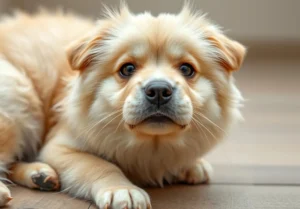Disclosure: We may earn a commission from helpful, relevant links in our content. No cost to you. See our privacy policy.
Think of your dog’s face when they see a new toy – that instant spark of curiosity, the wagging tail, those prancing paws.
And yet, with the thrill of a new plaything also comes the challenge of effective toy use for training.
Many of us have encountered our pets losing interest in their toys, or the headache of a pup that becomes a tiny terror whenever a favorite squeaker is involved. This blog is here to guide you like a compass through these rough terrains of dog training.
Trust us, by the time you’ve read our last word, you’ll be stepping into your pet’s playtime with confidence and a pocketful of actionable advice.

How to Introduce New Toys to Your Dog
Diving into a sea of new toys can be as daunting for your furry friend as it can be exciting.
The key is gradual introduction. Start by presenting one new toy at a time. Allow your dog to explore it at their own pace, familiarize themselves with its texture, sound, or scent.
Make sure to build anticipation by playing with the toy yourself first. A game of tug-of-war or catch with the new toy can spark their curiosity and make the toy more appealing.
It’s not just about plopping a new squeaky toy in front of them, it’s about making that toy an instrument of fun and connection between the two of you.
Creating a Reward System with Toys
Toys can be more than just a source of entertainment for your pooch; they can be a potent tool for reinforcing good behavior.
Develop a reward system using their favorite toys. When your dog follows a command or shows good behavior, reward them with playtime. It’s the dog version of a high-five or a pat on the back.
Choose toys that engage your dog’s instincts, like fetch toys for retrievers or chew toys for terriers. Reserve their absolute favorite for special achievements or more challenging commands. This not only enriches your dog’s training experience but also elevates the value of the toys in their eyes, making them an effective motivator.
Remember, the power of the toy reward system lies in timing. Present the toy reward immediately after your dog follows the command to create a clear link between obedience and fun.
As the saying goes in the dog training world – timing is everything, and in this case, it’s the secret to creating a reward system that works.
What to Do If Your Dog Loses Interest in Their Toys?
Even the most zealous dogs can sometimes lose interest in their toys. Don’t panic – it’s a common issue that many pet owners face, and the reasons can be varied.
One tactic is to rotate their toys. Having access to all toys at once can lead to sensory overload and eventually boredom. Try introducing a few toys at a time and rotate them every couple of days. This keeps the toys feeling new and interesting to your dog.
You might also want to check if the toys are suitable for your pet’s age, breed, and size. For example, Charlie, my untrained Golden Retriever, wouldn’t even bat an eyelid at a tiny squeaky toy meant for a Chihuahua. However, when I introduced a larger, more durable rubber chew toy, it was love at first bite. The toy’s size and resilience matched his breed’s natural preference, keeping him engaged for longer periods.
If your dog loses interest in their toys, introducing a fresh and exciting toy like the PetSafe Busy Buddy Tug-A-Jug can help renew their interest. This toy is engaging, durable, and suitable for larger breeds.
Lastly, don’t forget to join in on the fun! Your interaction can make even an old toy seem exciting again.

Dog Toy Aggression During Training: What to Do?
The first step is to recognize the signs of toy aggression, which might include growling, snapping, or a refusal to let go of the toy.
Once you identify this behavior, it’s crucial to respond calmly and assertively. Yelling or aggressive actions could escalate the situation, making it more stressful for both you and your dog. Instead, introduce the ‘drop it’ command. This command requires patience and consistent practice but can be an invaluable tool to manage toy aggression.
One unique technique that has proven beneficial is incorporating ‘trading up’ in your training. This involves offering a higher-value item or treat in exchange for the toy your dog is guarding. It’s a non-confrontational method that teaches your dog to willingly give up their toy because they understand something better is coming.
It’s worth noting that if your dog’s aggression seems severe or is causing concern, it’s best to consult a professional dog trainer or behaviorist. Every dog is unique, and sometimes professional guidance can make a world of difference in overcoming such challenges.
How to Make Your Dog’s Toys More Enticing
Toys, much like snacks, can lose their appeal if they are not presented in an intriguing way. It’s about making playtime an event that your dog looks forward to.
One method that has proven successful is to infuse the toys with scents that your dog enjoys. Whether it’s a splash of chicken broth or a dab of peanut butter, a familiar scent can make a world of difference.
I recall helping my neighbor Sarah with her Beagle, Max. Despite having a treasure trove of toys, Max was more interested in chewing on shoes. Knowing Beagles are driven by their noses, we experimented by rubbing a bit of bacon grease on his toys. The result? Let’s just say Max hasn’t looked at a shoe since.
The Role of Toys in Training Different Dog Breeds
Toys in dog training aren’t one-size-fits-all. Different breeds have different instincts, and their toys should cater to these instincts.
For instance, a Border Collie would appreciate a frisbee or a ball for a game of fetch, appealing to their herding instincts. A Labrador, with their history as a hunting dog, might enjoy a puzzle toy that can be ‘hunted’ and ‘caught’.
When I was training Sam, my well-trained German Shepherd, we used a variety of interactive toys. But his absolute favorite was the squeaky plush toy that resembled a squirrel. It satisfied his innate drive to chase, and it also became an excellent reward in obedience training.
Here’s a table outlining breed preferences regarding toys:
| Breed | Toy Preference | Why? |
|---|---|---|
| Border Collie | Frisbee | Stimulates their herding instincts |
| Golden Retriever | Durable chew toys | Satisfies their need to retrieve and carry |
| Beagle | Scented toys | Cater to their scent-driven nature |
| Boxer | Tug toys | Engages their natural desire for physically engaging play |
| Dachshund | Small plush toys | Mimics their burrowing instincts |
This video from Kikopup is really great to get you started:
FAQs
What if my dog isn’t interested in the training toys I bought?
Consider your dog’s breed, size, and personal preferences. If your dog isn’t showing interest, the toy may not be the right fit. Try a different type, texture, or size of toy, or try making the toy more engaging by infusing it with your dog’s favorite scent.
How can I tell if a toy is safe for my dog to play with?
To ensure a toy is safe for your dog, check its size, material, and durability. The toy should be large enough so your dog can’t swallow it and made of non-toxic materials. It should also withstand your dog’s chewing without breaking into small pieces.
What should I do if my dog becomes aggressive with their toy?
Stay calm and assertive. Introduce the ‘drop it’ command and consider the ‘trading up’ technique where you offer a higher value item or treat in exchange for the toy. If your dog’s aggression is severe or causing concern, consult a professional dog trainer or behaviorist.
Alex, a passionate animal lover, has experience in training and understanding animal behavior. As a proud pet parent to two dogs and three cats, he founded AnimalReport.net to share insights from animal experts and expand his knowledge of the animal kingdom.




